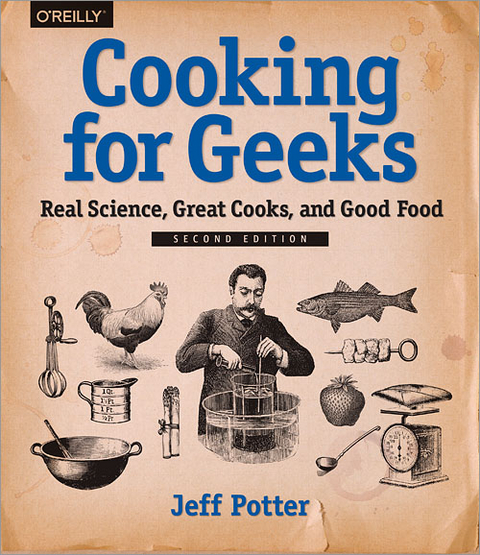
Cooking for Geeks
O'Reilly Media (Verlag)
978-1-4919-2805-9 (ISBN)
It allows them to test new food creations by applying the same technical approach they use to debug software or hack hardware.
Whether or not they know how to cook, this book helps readers discover a new method to cooking through experiments that let them see the algorithms behind recipes.
- Why do we cook the way we do?
- Are you the innovative type, used to expressing your creativity instead of just following recipes?
- Do you want to learn to be a better cook or curious about the science behind what happens to food as it cooks?
More than just a cookbook, Cooking for Geeks applies your curiosity to discovery, inspiration, and invention in the kitchen.
- Why do we bake some things at 350°F/175°C and others at 375°F/190°C?
- Why is medium-rare steak so popular?
- And just how quickly does a pizza cook if we overclock an oven to 1,000 F/540 C?
This book is an excellent and intriguing resource for anyone who enjoys cooking or wants to experiment in the kitchen.
- Discover what type of cook you are and calibrate your tools
- Learn about the important reactions in cooking, such as protein denaturation, Maillard reactions, and caramelization, and how they impact the foods we cook
- Gain firsthand insights from interviews with researchers, food scientists, knife experts, chefs, writers, and more, including author Harold McGee, TV personality Adam Savage, and chemist Hervé This
Jeff Potter is curious about the science of food and loves finding answers to why ingredients and recipes work the way they do. By bringing science to food-minded people—and food to science-minded people—he blends genres to educate the public about how to master the kitchen. He’s been featured in USA Today, the Today Show, and is a regular guest on Science Friday. He's even had the pleasure (and terror) of making a 500-pound donut for Food Network. A frequent speaker, he’s spoken across the globe, from Australia’s National Science Week to schools in Washington DC. When not in the kitchen cooking with friends, Jeff Potter works with organizations and tech startups, building the technology behind their products. He studied computer science and visual art at Brown University. He can be found online at www.jeffpotter.org.
Chapter 1Hello, Kitchen!
How to Think Like a Geek
Know Your Cooking Style
How to Read a Recipe
Fear in the Kitchen
A Brief History of the Recipe
Don’t Always Follow the Recipe
A Place for Everything and Everything in Its Place
A Dinner Party for One
The Power of a Dinner Party
The Basics of Kitchen Equipment
Chapter 2Taste, Smell, and Flavor
Taste + Smell = Flavor
Taste, the Gustatory Sense
Inspiration by Taste Combinations
Smell, the Olfactory Sense
What Is Flavor?
Inspiration by Exploration
Inspiration by Seasonality
Computational Flavor Inspiration
Chapter 3Time and Temperature
Cooked = Time * Temperature
85°F / 30°C: Average Melting Point of Fats
104–122°F / 40–50°C: Fish and Meat Proteins Start to Denature
140°F / 60°C: The End of the Danger Zone
141°F / 61°C: Eggs Begin to Set
154°F / 68°C: Collagen (Type I) Denatures
158°F / 70°C: Vegetable Starches Break Down
310°F / 154°C: Maillard Reactions Become Noticeable
356°F / 180°C: Sugar Quickly Caramelizes
Chapter 4Air and Water
Air, Hot Air, and the Power of Steam
Water Chemistry and How It Affects Your Baking
You Must Choose Your Flour, but Choose Wisely
Error Tolerances in Baking
Yeast
Bacteria
Baking Soda
Baking Powder
Egg Whites
Egg Yolks
Whipped Cream
Chapter 5Fun with Hardware
High-Pressure Situations
A Few Low-Pressure Tricks
Sous Vide Cooking: Low-Temperature Poaching
Making Molds
Wet Separations
Chilling Out with Liquid Nitrogen and Dry Ice
Cooking with a Lot of Heat
Chapter 6Playing with Chemicals
Food Additives
Mixtures and Colloids
Preservatives
Flavorings
Thickeners
Gelling Agents
Emulsifiers
Enzymes
| Erscheint lt. Verlag | 24.11.2015 |
|---|---|
| Verlagsort | Sebastopol |
| Sprache | englisch |
| Maße | 150 x 250 mm |
| Gewicht | 666 g |
| Einbandart | kartoniert |
| Themenwelt | Sachbuch/Ratgeber ► Essen / Trinken ► Grundkochbücher |
| Sachbuch/Ratgeber ► Natur / Technik | |
| Mathematik / Informatik ► Informatik ► Weitere Themen | |
| Schlagworte | Chemie • Geek • Geek Culture, kochen, Rezept, Kochbuch, essen • Kochen • Nerd Culture |
| ISBN-10 | 1-4919-2805-0 / 1491928050 |
| ISBN-13 | 978-1-4919-2805-9 / 9781491928059 |
| Zustand | Neuware |
| Haben Sie eine Frage zum Produkt? |
5 Buchhändler-Bewertung
von Steffen Ille (Buchhändler, Lehmanns Media Web-Redaktion), am 17.11.2015
Zahlreiche Informatik-Fachbücher heißen »Kochbuch« oder bieten »Rezepte« zur Lösung von IT-Problemen und -Aufgaben. Das ist kein Zufall, Kochen und Programmieren ähneln sich erheblich. In beiden Fällen ist ein strukturiertes Vorgehen ratsam, sollte das Lastenheft möglichst vollständig sein und steht die Frage, ob dem Kunden das Ergebnis am Ende zusagt (obwohl man sich strikt an die Anweisungen gehalten hat), in den Sternen. Jeff Potter geht daher ans Kochen auch genauso heran, wie es IT-Profis gewohnt sind, an Aufgaben heranzugehen und lädt dabei durchaus zum Probieren und Experimentieren ein.
aus dem Bereich



